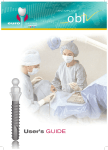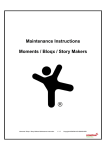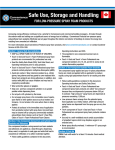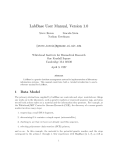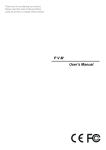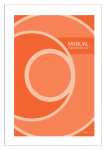Download OPERATING INSTRUCTIONS
Transcript
OPERATING INSTRUCTIONS PLATE HEAT EXCHANGERS SWEP INTERNATIONAL PHE AB ULTRA FLEX (GX)- System A system for heating and cooling fluids. With SWEP´s unique patented design, Ultra Flex asymmetrical flow channels can be obtained Ultra Flex system is available in 19 different plate sizes from 0.07 m2 to 3.3 m2. CONVENTIONAL (GC)-System Normal herringbone (chevron) pattern is ideally suited for handling aqueous solutions. DOUBLE WALL (GD)-System The double wall plate is perfect for a wide field of application where inter leaking of the heat exchanged media can cause undesirable or dangerous reaction. WIDE GAP (GF) A system for heating and cooling fluids. Suitable for strongly contaminated media, fluids containing solids and viscous products with a wide gap in flow channel of up to 12 mm SEMI WELDED PLATES (GW) The semi-welded plate heat exchanger consist of a number of plate pair ( also referred to an element) and a frame assembly. Plate pairs are laser welded together to form a sealed channel or element. A system for ammonia or very corrosive fluids. Index 1 2 General Description 3.2 3.3 4 Plates 3.1.1 3.1.2 3.1.3 3.1.4 3.1.5 Ultraflex GX plates Convential GC plates Double wall GD plates Wide Gap GF-plates Semi welded GWplates 3.1.6 Plate Identification Number of Heat Transfer Plates Suitable Glue Gaskets 3.3.1 GX-plates 3.3.2 GC-plates 3.3.3 GF-plates 3.3.4 GW-plates Frame & Connections 4.1 4.2 4.3 5 General advice / dangers Plates & Gaskets 3.1 5.1 5.2 7 7.2 7.3 7.4 7.5 7.6 7.7 7.8 7.9 8 Erection Lifting & handling Opening the heat exchanger 7.1.1 Taking out the plates 7.1.2 Cleaning the plates 7.1.3 Plate cleaning tips Adjusting the gaskets Cleaning the gasket groove Suitable gasket glue 7.4.1 Glueing the gasket Assembly Tightening the heat exchanger Lubrication CIP (Cleaning In Place) Back Flushing and strainers Trouble shooting 8.1 9 Initial operation Pumps Start-up Venting Shut-down 6.5.1 Storing the PHE Maintenance 7.1 Specification Sheet Pass & Flow arrangement 4.2.1 Working principle 4.2.2 Cooler Module Special arrangement for draining multipass unit Installation Operation 6.1 6.2 6.3 6.4 6.5 Identification of unit 2.1 3 6 Rectifying a leaking PHE 8.1.1 Localizing the leak 8.1.2 Determining which liquid is leaking 8.1.3 Types of gaskets failures Gasket Storage Procedure 1. GENERAL DESCRIPTION The Plate Heat Exchanger (PHE) consist of corrugated heat transfer plates, frames, carrying bar, connections and tightening bolts. The corrugated plates are held in between the fixed and moveable cover and are compressed by tightening bolts. Optional shrouds are available on request. The heat exchanger`s construction enables a plate heat exchanger to be easily opened for inspection, cleaning and extension. Elastomer gaskets are glued in the gasket groove around the heat transfer surface and holes. The gaskets are double around the holes to prevent leakage between the media. In the event of gasket failure the medium runs straight out of the exchanger. When the unit is tightened, the gasket seal the structure and, in conjunction with the port holes, allow fluids to flow in alternate channels and almost always flow counter-currently. The thin fluid interspace coupled with the corrugated plate design induces turbulence that produces extremely high heat transfer coefficients. Plates are manufactured in standard sizes in virtually any material that can be cold worked. The size, number and arrangement of the plates is contingent upon the duty to be performed. Accordingly, the units are custom designed or each application. Picture 1. 2. IDENTIFICATION OF UNIT Each SWEP PHE is provided with a machine plate attached to the fixed cover. It gives details of: 1. Plate heat exchanger type 2. Serial number 3. Year of construction 4. Channel arrangement 5. Permitted working pressure range (bar) 6. Permitted working temperature range (°C) MACHINE PLATE Picture 2. 2.1 GENERAL ADVICE/DANGERS • All work on the PHE is to be carried out in compliance with the existing regulation, e.g. the accident prevention regulation • Shut-down should take place slowly, make sure the unit NOT is under pressure. • Cool the heat exchanger. If possible allow the heat exchanger to stand and cool overnight. • When handling heat exchanger plates. Always USE GLOVES to prevent injuries to the handsthe plate edges are sharp! Picture 3 3. PLATES & GASKETS 3.1 PLATES The plates and gaskets are the main component of your PHE. Please always use original SWEP parts to guarantee the performance and lifetime. 3.1.1 ULTRAFLEX (GX) PLATES SWEP International PHE AB Ultraflex means that every single plate can form two channels. With the gasket groove in the plate`s neutral plane the plate can be rotated about its x-axis as well as its y-axis. New flow channels are formed with new thermal characteristics. HS HD MS Every plate size is available with two different angle combinations thus forming six different flow channels for every plate size. LS MD LD The GX series of plates is based on a diagonal flow pattern and have gasket groove in the neutral plane. The heat exchange plates are made with two different arrowhead angles: one obtuse having high-theta plate (high resistance to flow), and one acute giving a low-theta plate (low resistance to flow) A GX plate is identified by means of an embossed code letter. This letter can be found to the RIGHT of the UPPER carrying bar cut-out, when the plate is facing TOWARDS the fixed cover plate. GX Low-theta plate GX High-theta plate 3.1.2 DOUBLE WALL (GD) PLATES A plate heat exchanger with double-wall plates works in the same way as a conventional exchanger. The only difference is that each plate consists of two identical plates welded together around the port holes. When manufacturing a double-wall plate you start with two plate sheets (thickness 0.3 mm) where only the port holes are cut. The next step is to weld the plates together around the port holes. After this a net (thickness 0.7 mm / ¨12.5) is placed between the plates and the plates are pressed with a conventional tool leaving clear tracks from the net in the plates. These tracks will function as leak tracks when the plates are in use. Finally the net is removed and the plates are pressed once more, this time with the standard pressing tool. Gaskets FUNCTION Fluid 1 In the event of any leakage the double-wall plate prevents the media from mixing with each other. In stead an external leakage will occur. The leak will be clearly visible outside the exchanger whether it is a plate, a gasket or a weld that has caused the leak. Examples of applications are: • pharmaceutical industry • nuclear industry • petrochemical & chemical industry • food industry • HVAC heating of utility water Fluid 2 3.1.3 CONVENTIAL (GC) PLATES The heat exchange plates are made with two different arrowhead angles: one obtuse having high-theta plate (high resistance to flow), and one acute giving a low-theta plate (low resistance to flow) The GC series of plates is based on a parallel flow pattern and have gasket groove in the bottom plane. Each plate have one gasket. GC Low-theta Plate GC High-theta Plate 3.1.3 WIDE GAP (GF) PLATES Wide-Gap plates are most effective in applications which involve viscous fluids or solids and slurries. The GF plates have a draw depth of two to five tines greater than conventional plates. This permits unrestricted passage of coarse particles or fluids containing fibres normally cause extensive clogging and downtime for cleaning with standard Plate Heat Exchangers. Examples: • Pulp & Paper industry - Heating / Cooling of fibrous material • Sugar Processing Industry - Heating / Cooling of fruit juices • Heat Recovery for industrial applications e.g. waste water, dye works, paper manufacture • Wide-Gap plates are excellent for low pressure steam because the wide gap will more readily accommodate the high volumetric flows typical of low pressure steam applications. SWEP new generation of Wide Gap plates can be arranged in a wide /narrow configuration when only fluid with large particles requires a wide gap, or placed in a medium/medium position when both fluids need the additional flow area. Both configurations are accomplished with a single plate geometry. Maximum gap between channels is 12 mm. The GF series of plates is based on a parallel flow pattern and have gasket groove in the bottom plane. Each plate have one gasket. GF Wide Gap Plate 3.1.4 GW-PLATES Plate pairs are laser welded together to form a sealed channel or element. In order to close off or seal two of the four portholes in the element, a laser weld is extended diagonally in front of the two vertically aligned ports. Refrigerant (or corrosive fluids) which enters the sealed channel through the inlet port, flow inside the element. Picture 5. Narrow Special designed, double ring gasket are placed on the either side of the inlet and outlet ports, thereby creating a seal around the ports. This will decrease the rate of permeation from a low level to zero. Perimeter gaskets (also referred as Parallel gasket) are placed on either side of the element, creating a sealed envelope to contain the process fluid. The process fluid flows between the elements in the gasketed channel. Wide Picture 4. GW-81/82 element, wide/narrow channel. SWEP are pressing two different plates, one asymmetric and one symmetric plate and can hereby create 3 different Elements / channels with different thermal characteristics. Double ring gasket will decrease the rate of permeation from low level to zero. GW-81 - Two asymmetric plates welded together with a narrow channel inside the element. The element is marked in the upper part with letter O. GW-83 - Two symmetrical plates welded together. The element is marked in the upper part with letter S. GW-82 - Two asymmetrical plates welded together with the wide channel inside the element. The elements is marked in the upper part with letter W. The GW plates have a parallel flow pattern. 3.1.4 PLATE IDENTIFICATION NUMBER OF HEAT TRANSFER PLATES A five digit number is stamped into each plate when it is pressed. This number is a code to identify the material of the plate. The first digit Year of manufacture; last figure in year. 1998 The second digit Quality of material; see below rd th th The 3 +4 + 5 charge digits Running number for each Second Digit 0 1 3 4 5 6 7 8 9 Material AISI 304 AISI 316 654 SMO 254 SMO or other qualities of S/S Titanium Grade 1 Titanium Grade 11 Alloy C-276 G-30 Other materials Example: 81103 AISI 316 material, manufactured in 1998. If Code number is stated, SWEP can trace material certificate. 3.2 SUITABLE GLUE SWEP International PHE AB are using onecomponent glue to fasten the gasket to the plate. The advantages are: • The gasket will not fall off when the unit is opened • Not necessary to clean gasket groove before re-gluing. • Possible to make maintenance at site. • The gasket is easy to remove, not necessary to send plates away to original supplier. Only certain glues may be used for gluing gaskets, namely: BOSTIK 1782 BOND SPRAY 77 3M EC 1099 PLIOBOND 20/30 Synthetic glue SILAPRENE 6249 Do not use other types of glue, they may contain chlorine or other substances which attack the plate material. To facilitate application with a brush, the glue should be diluted with acetone. Maximum dilution 1:1. The number of gaskets which can be glued from one bottle of Pliobond 20 may be approximated as follows ( 1 litre = 1 can): Model GX-6 GX-12 GX-18 GX/GC-26 GX-42 GX/GC-51 GX-64 GX-91 GX-118 GX/GC-60 GX-100 Number of gasket/ litre 100 100 70 60 40 34 36 30 26 40 36 Model GX-140 GX-180 GX-85 GX-145 GX-205 GX-265 GX-325 GF-57 GF-97 GF-187 GW-80 Number of gasket/ litre 28 30 32 28 24 20 16 40 36 30 3.3 GASKETS The elastomer gaskets are available in various materials, All gaskets are marked with a code colour to be able to identify the gasket material. Material Nitrile Nitrile(P) HNBR EPDM(P) Fluor GB Viton GF Colour Code No marking 3 blue stripes 2 blue stripes 1 grey strip 1 mauve strip 3 mauve stripes Max. Temperature 110°C 140°C 150°C 160°C 180°C 150°C The temperatures given are maximum values and may be reduced depending on medium for your specific application; the maximum operating temperature and the maximum operating pressure. Arrenhius correlation: For every 10 degrees higher operating temperature the life time of the elastomer gasket is reduced with 50%. The gaskets have two other markings 1) Quarter of Manufacture The two last digits of the year of manufacture and a number of dots representing the quarter of manufacturing. Example: 95 .. is manufactured in the second quarter of 1995. 2) Mould Number The marking states which mould the gasket was manufactured in The gaskets are double around the holes to prevent leakage between the media. In the event of gasket failure the medium runs straight out of the heat exchangers. 3.3.1 GX-PLATES AND GD-PLATES GX heat exchanger plates differ from conventional plates. Because the gasket groove lies in the plate´s neutral. The gaskets used next to the cover plates are half thickness. First and last plate requires two half thickness gasket each. Half thickness gasket GX-6/51 One start or end plate require 2 half thickness gasket Half thickness gasket GX-37/325 exist of 2 loose rings One start or end plate require 2 half thickness gasket, but 4 rings Start/end plate - 2 half thickness gaskets + straights For a complete PHE with 101 plates, 100 full thickness + 4 half thickness gaskets are required. It´s important to follow the gluing instruction from the plate specification sheet. A normal plate pack is glued 50% Right and 50% Left, depending of H (RIGHTG / LEFTC) or L (RIGHTS / LEFTL) plates. First plate is glued FRONT - RightG / RIGHTS with half thickness gaskets front Last plate is glued BACK - Half thickness gasket back RIGHT G - Letter G up to the right, the ring down to the RIGHT LEFT C - Letter C up to the right, the ring down to the LEFT RIGHT S - Letter S up to the right, the ring down to the RIGHT LEFT L - Letter L up to the right, the ring down to the LEFT Note: To keep the correct connection denomination 1,2,3 and 4 you should have the letter (K) for Lowtheta plate and the letter (B) for High-theta plate in the upper right corner. 3.3.2 GC-PLATES This range of plates has the gasket groove in the plate´s bottom plane. Every plate has one gasket glued on the front side. The first plate have rings around all ports, and the channel plates have rings around port 1 and 2. For a complete PHE with 50 plates, 49 channel + 1 start gaskets are required. Picture 6. Start Picture 7. Parallel 3.3.3 GF-PLATES GF heat exchanger plates differ from conventional plates. Because the gasket groove lies in the plate´s neutral. The gaskets used next to the cover plates are half thickness. First and last plate requires two half thickness gasket each. The full gasket can be glued in two different ways depending on the channel arrangement. Please check plate specification page . PARAL - The letter L in the upper right corner, the gasket on the left side PARAS- The letter S in the upper right corner, the gasket on the left side 3.3.4 GW-PLATES The GW-plates has the gasket groove in the plate´s bottom plane. Every element has one parallel gasket and two O-ring gaskets glued S3/S4. The start plate have special start O-rings-gaskets glued on the front side. 2 start O-rings for S1/S2 and 2 start O-rings for S3/S4. START -plate 2+2 O-rings PARALLEL- 1 parallel gasket and two double O-ring gaskets 4. FRAME & CONNECTIONS The frame denominations are: Design Pressure bar 10 16 25 Mild steel with End support N P S Mild steel without End support NI PI SI SWEP PHE`s are supplied with two frame designs, with and without end support Picture 8 Picture 9 The pipe connections are positioned either on the fixed cover alone or on the fixed cover and the moveable cover. The position of the pipe connections is described in the picture below. Flange connection with Port liner Threaded connection ISO 7/1 Weld connection 4. 1 SPECIFICATION SHEET Each PHE is supplied with a specification sheet. The sheet gives detailed information of unit, location of connection and plate specification. The plate specification assist in determining the proper sequence and orientation of the plates in the unit. You will note that the gaskets used between the first and last plate of the plate pack and the respective frames are half thickness. For the GX and GF units the code is giving the embossed letter see part X.X and for GC units it shows arrow direction UP and DOWN Example 1: PLATE ASSEMBLY for GX - plates Plate type GX-51 Type H L H H Ports 1234 1234 1234 0 GasketMtr NBR(P) Front None NBR(P) Back Gaskets 1 Diag None 35 From 1 2 3 35 To B 34 33 B Code 1 RS CB 1 Qty 17 16 According to the assembly instructions, an installer should stand at the front of the unit and read in the upper corner (S1) as: Plate 1 Plate 2 Plate 3 Plate 4 Plate 5 Plate 6…… B R C S B R…. Example 2: PLATE ASSEMBLY for GC-plates Plate type GC-51 Type L L L L Ports 1234 1234 1234 0000 GasketMtr NBR(P) Start Gaskets 1 Parallel 2 Parallel 3 Parallel 50 From 1 48 49 50 To Dn Up Dn Up Code 1 24 24 1 Qty According to the assembly instructions, the plates should be hanged as follows: Plate 1 Plate 2 Plate 3 Plate 4 ……. Arrow Down Arrow Up Arrow Down Arrow Up 4.2 PASS AND FLOW ARRANGEMENT 4.2.1 WORKING PRINCIPLE Multi Pass unit Single pass Sea Water Fresh Water A Cooler Module B C Lube Oil 4.3 SPECIAL ARRANGEMENT FOR DRAINING MULTIPASS UNIT The blank ports (2 and 3) in the turning plate for two-pass grouping and the first turning plate for three-pass grouping are provided with holes, 3 mm diameter for small units and 6 mm diameter for large units. The larger units GX-37/64/91/118, GX-60/100/140/180 and GX85/145/203/265/325 require a partition plate after every turning plate to prevent deformation of the blank ports in multipass grouped heat exchangers. 5. INSTALLATION SWEP`s plate heat exchangers are pressured tested at the factory before delivery. 5.1 ERECTION The heat exchangers must be installed with clearance on both sides: Clearance Size 300 mm GX-6, GC-12, GC-28 600 mm GX-12/18/26/42, GC-26, GC-30 1000 mm GX-51/37/64/91/118, GC-51 1200 mm GX-60/100/140/180, GC-60, GF-57/97/187 1500 mm GX-85/145/205/265/325 5.2 HANDLING AND INSTALLATION Picture 10. Please note! The PHE must not be lifted by the carrying bar or the connections. Use only the lifting holes provided. All connections to the heat exchanger must be provided with shut-off valves. The lower connections (S2 and S3 ; M2 and M3) must be provided with drain valves. The upper connections S1 and S4 ; M1 and M4) must be provided with venting devices at their highest points. The hot side`s regulating valve should be installed in the feed pipe between the pump and the shut-off valve. M4 M1 M3 S4 M2 S1 Movable cover, M S3 S2 Stationary cover,S All connections to the movable cover must be made using removable 90 degree elbows, allowing the movable cover to be pushed back for servicing. All nozzle loading must be minimised during installation and operation. Thermal expansion of the piping must not affect the PHE. In case of welding, the PHE must not be used as a grounding mechanism as electric arcs may occur between the heat transfer plates. 6. OPERATION 6.1 INITIAL OPERATION Check that the operating data does not exceed that given on the heat exchangers machine plate. Check that all tightening bolts are properly tightened. Check that all connection pipes are screwed tight Check that the A-dimension is correct. The A-dimension can be found in the specification sheet. 6.2 PUMPS Pumps feed the heat exchanger must be provided with regulating valves. If the pumps can deliver a higher pressure than the rated pressure for the heat exchanger, safety valves must be installed. The pumps must not suck in air. 6.3 START-UP To avoid pressure shock the pumps must be started against closed valves. The valve in the inlet and outlet should be opened at the same time as far as possible. The flow rate is then increased slowly until operating temperature is reached. Hammering must be avoided, otherwise the rubber gaskets may be displaced and cause leakage. 6.4 VENTING Immediately after the start-up the exchanger must be vented. Remaining air can cause air locks and serious scorching of the plates, reducing the heat transfer capacity and increasing the risk of corrosion. 6.5 SHUT-DOWN If the PHE is to be shut-down briefly, proceed as follows: Slowly close the feed valves, staring with the feed line with the higher pressure. Switch off the pumps Close the valve in the outlet pipes, if present. For longer periods of down-time and especially when there is a risk of freezing or if the media are aggressive, the heat exchanger must be emptied and cleaned. While the unit is not in use, ease the tension on the tightening bolts so that the plates just lie against each other, but close enough to prevent any dirt entering between them. The tightening bolts should be greased. 6.5.1 STORING THE PHE If it is necessary to store the PHE before initial operation for an extended period (1 month or more), SWEP recommend action to prevent premature wear of the materials The tightening bolt should be greased and all connections should be covered. Picture 11. 7. MAINTENANCE 7.1 OPENING THE HEAT EXCHANGER Cool the heat exchanger. If possible allow the heat exchanger to stand and cool overnight. Disconnect any connection to the moveable cover Remove Bolts ¶ Slacken nuts ·, ¸ and ¹ alternatively so that the moveable cover can move parallel with the frame plate Remove bolts ¸ and ¹ Slacken nuts · alternatively 7.1 TAKING OUT THE PLATES 7.1.1 USE GLOVES - THE PLATE EDGES ARE SHARP! If two or more plates have stuck together they must be separated carefully so that the gaskets are kept on the correct plate. The plates support each other in pairs. If a plate has been so damaged that it must be taken out and cannot be repaired or replaced with an identical one, is adjacent plate must also be taken out of the heat exchanger. If the number of plates are changed, so is the A-measurement (See xxx) Special plates, such as the first and last plates and turning plates in multipass heat exchangers, must be replaced with identical plates 7.1.2 CLEANING THE PLATES Fouling of the plate heat exchanger often depends on the flow velocity through the heat exchanger being too low. Where the possibilities exists to increase the flow this should be tried out if the heat exchanger shows signs of reduced capacity or increased pressure drop. However, with products that crystallize or heavily foul the plates or if the heat transfer surfaced have been scorched, opening and cleaning the heat exchanger is necessary. • The heat exchanger is opened according to 7.1 • Steel wool or brushes of carbon steel must not be used, nor may stainless steel be used on titanium plates. • In the first place the heat transfer surface is cleaned by rinsing with a powerful jet of water and scrubbing with a nylon or similar brush. • Take care not to damage the gaskets. • The gaskets must be wiped dry with a cloth. Solid particles adhering to the gaskets cause damage and result in damage and result in leakage when the unit is put back in operation. • The lower portion of each plate as hung in the unit should be inspected carefully and cleaned appropriately as this is the primary area where residual solid material tends to accumulate. Do not use chlorine or chlorinated water to clean stainless steel or Nickel alloys. Chlorine is commonly used to inhibit bacteria growth in cooling water systems. Chlorine and chlorinated water can rapidly attack the above mentioned materials. For any applications where chlorination must be used with nontitanium equipment, please contact the Sales office. 7.1.3 PLATE CLEANING TIPS • Do not use hydrochloric acids, or water containing in excess of 300 ppm chlorides, with stainless steel • Do not use phosphoric or sulfamic acid for cleaning titanium plates. • Limit cleaning solution concentration to 4% strength, with temperature not exceeding 60°C unless otherwise specified. General guidelines for cleaning are tabulated below: Type of Fouling Calcium Sulphate, Silicates Calcium Carbonate Alumina, Metal oxides, Silt Biological growth Greasy deposit Suggested cleaners Citric, Nitric, Phosphoric or Sulfamic acid 10% Nitric acid Citric, Nitric, Phosphoric or Sulfamic acid (To improve cleaning add detergent to acid) Sodium Carbonate or Sodium Hydroxide (NaOH) Kerosone and a soft brush. After cleaning, rinse thoroughly with water Important: NaOH and concentrated Nitric acid can seriously harm the skin and muscous membranes. The solution must be handled with the greatest care. Always wear protective goggles and protect hands with rubber gloves. 7.2 ADJUSTING THE GASKETS A gasket that has come loose, either partly or entirely, must be glued in place. If only a short length has become detached, glueing can be carried out immediately before clamping, with the plate still sitting in the frame. If the entire gasket has become detached, the plate should be taken out of the heat exchanger. 7.3 CLEANING THE GASKET GROOVE The solvent must not contain chlorine. Clean the plates from residues of old gasket- Small patches of glue, hard to remove, that are securely stuck to the gasket groove may remain there. They provide an excellent foundation for the new gasket. Wash the gasket groove so that it is completely free of oil and other greasy substances, using a rag and acetone or other solvent not containing chlorine compounds. Then let the plate dry off. 7.4.1 GLUING THE GASKET The glue is applied with a small flat brush to those parts of the plate`s gasket groove in which the gasket shall lie. These parts of the gasket groove are easily recognised as they differ in colour arising from previous residues of glue. The gasket is then placed into position on the plate. After drying for about 30 seconds ( the time depends on the thickness of the glue film and how much the glue has been diluted), the glue holds the rubber gasket firmly in place in the gasket groove, thus facilitating mounting. The plate must then be held under light pressure with the aid of other plates or a stiff sheet of other material of suitable weight for about an ½ hour. When the glue joint has dried the gasket should be coated with talc to prevent the plates subsequently sticking to each other. The plates are then ready to assemble into the frame. 7.5 ASSEMBLY Before the heat exchanger is assembled, inspect all gaskets and surfaces that lie against the gasket. Particles that may jeopardize the integrity of the seals or damage the gasket or sealing surfaces must be removed. Note that contaminants usually collect at the lower part of the plates. Plates that have been provided with new gaskets must be checked to make sure that the gaskets are in the correct gasket groove. Also check the half thickness gaskets on the first and last plates. Use the specification sheet see xx to insert make certain that the plate pack is assembled correct. The plate edges form a regular honeycomb pattern. 7.6 TIGHTENING THE HEAT EXCHANGER The plate pack must be compressed to a specific thickness - the A-dimension. The A-dimension +/3% gives the inside length in millimetres between the fixed and moveable cover. Size GX-6 GX-12/18 GX-26/42/51 GX-37/64/91/118 GX-60/100/140/180 GX-85/145/205/265/325 GC-28 GC-26 GC-51/60 GC-12/30 GF-57/97/187 Plate Thickness 0.5 mm 0.5 mm 0.5 mm 0.5 mm 0.5 mm 0.5 mm 0.4 mm 0.5 mm 0.5 mm 0.6 mm 0.8 mm A-DIM A-dimension 3.0 x number of plates 3.4 x number of plates 3.8 x number of plates 3.4 x number of plates 3.8 x number of plates 3.8 x number of plates 2.6 x number of plates 4.5 x number of plates 4.7 x number of plates 3.1 x number of plates 8.8 x number of plates NEVER TIGHTEN THE HEAT EXCHANGER WHILE IT IS UNDER PRESSURE! Example 1 : A PHE GX-12 has a total of 37 plates ( 0.5 mm AISI 316) The A-dimension is: 3.4 x 37 = 125.8 mm +/- 3% Example 2 : A PHE GX-12 has a total of 37 plates (0,6 mm AISI 316) The A-dimension is : 3.5 x 37 = 129.5 mm +/- 3% NOTE: With large plate packs the A-dimension, due to tolerances in the plate thickness and depth of pressing, can deviate somewhat from that given above, +/- 3%. With the correct A-dimension the plate lie in metallic contact with each other. Check this by examining the plate edges around the heat exchanger. Further compression can deform the plates. The nuts must be tightened alternatively. The movable cover plate must always be moved parallel to the frame at all times, and not drawn out of alignment. Tighten bolts ¸ alternatively. As the resistance increased also tighten bolts ¶ and · always alternatively. Tighten bolts ¹ Check the A-dimension along the heat exchanger 7.7 LUBRICATION The tightening bolts must be kept lubricated with molybdenum disulphide or its equivalent, particularly on the section of thread used for opening and closing the equipment. 7.8 CIP (CLEANING IN PLACE) Cleaning-in-place is the preferred cleaning method when especially corrosive liquids are processed in a plate heat exchanger unit. Install drain piping to avoid corrosion of the plates due to residual liquids left in the unit after an operation cycle (FIGURE) To prepare the unit for cleaning, follow the procedures listed below: 1. Drain both sides of the unit. If it is possible to drain, force liquids out of the unit with flush water. 2. Flush the unit on both sides with warm water at approximately 40 C until the effluent water is clear and free of the process fluid. 3. Drain the flush water from the unit and connect CIP pump 4. For thorough cleaning it is necessary to flow CIP solution bottom to top to insure wetting of all 5. 6. surfaces with cleaning solution. When cleaning multiple pass units it will be necessary to reverse flow at least ½ the cleaning time to wet all surfaces. For optimum cleaning, use a flow rate of water, rinse and/or CIP solution that is greater than normal product rate of flow. A CIP operation will be most effective if performed on a regularly scheduled basis and before the unit is completely fouled. Flush thoroughly with clean water after CIP cleaning. 7.9 BACK FLUSHING AND STRAINERS Often, when fibers or large particles are present, back flushing of the unit proves to be very beneficial. This is accomplished by either of the following methods: 1. Flush the unit with clean water in reverse flow to the normal operation direction. 2. Arrange piping and valves so the unit may be operated in reverse flow mode on the product side for fixed periods of time. This method is particularly well suited for steam- to - product units. 3. The use of strainers are recommended in supply lines ahead of the exchanger when the streams contain significant solids or fibers. This will reduce the requirements for back flushing. 8. TRUBLE SHOOTING 8.1 RECTIFYING A LEAKING PHE General Measure the A-dimension (plate pack thickness) at several points around the plate pack. Compare with theoretical value. Check that the covers are parallel and not drawn out of alignment. If a PHE is leaking, it is important to localize the leak before the unit is dismantled, otherwise it often becomes more difficult to rectify the problem. To rectify a minor leak, it may be sufficient to tighten the unit a bit further. Ensure that the plate pack is not tightened below the minimum A-dimension. 8.1.1. Localizing the leak The unit should be inspected thoroughly on all sides including top and bottom of the plate pack. Pinpoint all leaks by counting the number of plates from a cover and by accurate measurements. If possible, connection ports that are not under pressure should be inspected for leaks. There are, in principle, four different types of leaks: 1.1 Through the leakage vent from the area between ring and diagonal gasket. 1.2 Through an external gasket on the side of the plate pack. 1.3 Internal leakage. 1.4 Leakage at the nozzle lining. 1.1. Leakage through the leakage vent: The most common reason for this type of leakage is gasket failure; either the ring or the diagonal gasket. If the gaskets are in good condition and correctly located in the gasket grooves, check for possible corrosion in the areas between the ring and diagonal gasket by visual inspection or dye penetration. 1.2. If a leakage occurs over a gasket on the side of a plate pack at any position excluding the ones described in 1.1, the gasket and its correct location in the gasket groove should be inspected. The sealing surfaces (gasket & groove) must be free from dirt that may jeopardize the integrity of the seal. 1.3. If there is an internal leak in a plate heat exchanger, the reason is probably a hole/crack in a plate caused by corrosion or mechanical damage. To localize this type of leak, it is necessary to disconnect one of the lower connections, pressurize the other side and observe where the drops come from. Note that it may be necessary to switch sides to find the hole or crack. Measure the distance from the cover to the leak to determine which plates are suspected. Check these plates visually and by dye penetration. For multi pass units, it may be necessary to remove turning plates to see through the whole plate pack from the connection. 1.4.If a leak occurs adjacent to a frame cover near a port, the reason could be: • Cracks in the metal liner results in leakage between the cover plate and the liner. If this occurs on the inside of the cover, it is often easy to see. If it occurs on the outside of the cover, it can sometimes be difficult to see the difference between this and a leaking gasket for the connection flange. • A leak at the cover inside can also be caused by the ring gasket on the first plate not sealing correctly to the liner. If this is due to incorrect centering of the liner/ring gasket, it can be remedied by adjusting the carrying bar. In certain cases, it may be possible to adjust the liner somewhat by moving it sideways in the cover port hole. 8.1.2. DETERMINING WHICH LIQUID IS LEAKING If both liquids in the heat exchanger are the same, it is possible to determine which of the two liquids is leaking: 8.1.2.1 EXTERNAL LEAKAGE ON THE SIDE OF THE EXCHANGER: If the unit is assembled according to SWEP standard, the liquid in the first channel (that is the channel formed by plate numbers 1 and 2) corresponds to connections 2 and 4. Channel No Even Odd Corresponds to connection 1 and 3 2 and 4 8.1.2.2 LEAKAGE THROUGH THE LEAKAGE VENT: If only one side of the exchanger is pressurized, and the leak occurs through the leakage vent, the following applies: Pressurized connections 1 and 3 2 and 4 Leakage from channel with even no Leakage from channel with odd no Diagonal gasket failure Ring gasket failure or hole in plate between ring and diagonal gasket Diagonal gasket failure Ring gasket failure or hole in plate between ring and diagonal gasket 8.1.3. TYPES OF GASKETS FAILURES 3.1. Gaskets not located correctly in the gasket groove 3.2. Gasket crushed (split). This is caused by excessive deformation of the rubber material by, for example: • excessive tightening of the plate pack • swelling of the gasket material by chemical attack and/or high temperatures. • gaskets squeezed between contact point due to incorrect location of the gasket in the groove. Note: Certain types of elastomers are more sensitive to crush, especially peroxide cured qualities and fluorinated rubbers. 3.3. Gasket attacked chemically by the liquid. This can lead to the gasket being dissolved, swelled, hardened etc. 3.4. Gasket has lost its elasticity due to heat ageing. 9. GASKET STORAGE PROCEDURES If the rubber gaskets are stored under unsuitable conditions, the physical properties of the rubber material may change, resulting in a hardness change, permanent deformation, cracks or other surface damage. The changes can be caused by, for example, the oxygen in the surrounding air, ozone, heat, light, humidity, solvents or mechanical forces. If the rubber parts are handled and stored correctly, they will maintain their properties for a longer period. • Storage room should be cool, dry, free from dust and only moderately ventilated. It should also be relatively dark and protected from direct sunshine. • The room temperature should be between 15°-20° C with a relative humidity of maximum 70%. • Store gaskets so they are free from tension. Do not store in a stretched or severely bent condition. • All potential sources of ozone, such as operating electric motors, or welding equipment, must be removed from the storage area. Information in this brochure is subject to change without notice. The manufacture reserves the right to change specification at any time. In any correspondence with SWEP International PHE AB concerning your PHE, please always quote the serial number, plate heat exchanger type and year of construction.



























